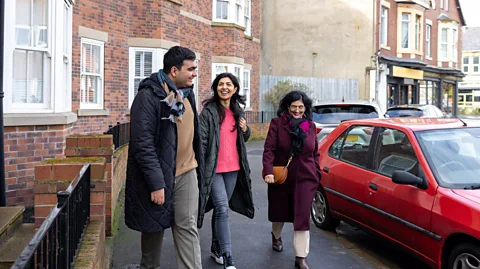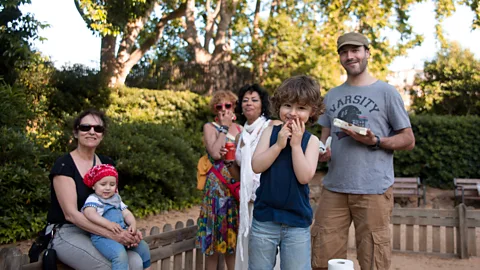Autism diagnoses are on the rise – but autism itself may not be
 Getty Images
Getty ImagesAutism is better known and diagnosed than ever before, leading to misconceptions that cases are skyrocketing.
When it came to her son's autism diagnosis, in some ways Shannon Des Roches Rosa feels she was lucky. What autism spectrum disorder (ASD) looks like can vary greatly between individuals, as well as between groups of people – girls' symptoms often differ from boys', for example. But as a young, white boy, her son, Leo, was part of a group with especially well-established diagnostic criteria.
And some of these criteria had been noticed by other people. As a toddler, Leo rarely made eye contact. In nursery school, he didn't respond to speech like the other kids. He frequently showed compulsive behaviours, like flapping his hands and chewing his clothes. He was easily stressed or overwhelmed. As a result, his diagnosis in 2003, at age two, was relatively straightforward.
But Rosa wasn't given much guidance about next steps. "I felt very lost," says Rosa, an editor and mother of three who lives in California. "I was really angry." Like so many other parents, what she wanted to know, above all, was why her child had autism. Online, she found other parents seeking the same answers.
Some believed their children had been injured by vaccines. Numerous studies on hundreds of thousands of children have consistently found no link between vaccinations and autism, and vaccinated children don't have higher autism rates than non-vaccinated children. But without a clearer understanding of why Leo was autistic, Rosa chose not to vaccinate her other children.
Over the years, Rosa realised she had been mistaken. Not only did Rosa eventually renounce her opposition to vaccination, she started a website, Thinking Person's Guide to Autism, to help others. "I have sympathy for people who believe this stuff because I've been there," she says. "But now I know that that was misinformation."
 Getty Images
Getty ImagesRosa's story is an example of how, following an autism diagnosis, some families just want clear answers. Earlier this year, the US Health Secretary Robert F Kennedy Jr promised a "massive" research effort involving hundreds of scientists, to get to the bottom of what he has called an autism "epidemic" before September 2025.
But decades of research into autism have shown that its causes are complex – and mostly genetic. (Read more from the BBC about the genetic mystery of why some people develop autism.) Experts say the biggest reason for the rise in autism diagnoses, though, likely isn't these causes at all – it's a shift in how we screen for and diagnose the condition.
Autism is a neurodevelopmental disorder which often involves differences in thinking patterns, sensory processing, communication and social interactions. Autism prevalence is estimated at roughly 1% to 3% across the countries where it has been studied, although data is lacking in many low- and middle-income nations.
In places that have been tracking this data over decades, there has been a steady rise in autism diagnoses since the mid-20th Century. Based on health and education records, from 2000 to 2022, autism prevalence in the US increased from 1-in-150 to 1-in-31. Prevalence has also grown in Australia, Taiwan, and other countries.
"That can look alarming to people who don't know [the context of the statistics]", says Zoe Gross, the director of advocacy at the Autistic Self Advocacy Network (ASAN), a US nonprofit run by autistic people. It's not necessarily that autism cases are increasing, Gross emphasises: rather, diagnoses are on the rise.
As a recognised separate condition, autism is relatively new. It wasn't included in the Diagnostic and Statistical Manual of Mental Disorders (DSM) – a book with details on the symptoms and recommended treatment of hundreds of mental conditions – until 1980. This means that before then, children with ASD often got misdiagnosed with a condition like schizophrenia, or were never diagnosed at all, Gross says. But even this recognition proved narrow. The 1980 criteria included, for example, an onset before 30 months of age, lack of responsiveness to other people, and language delays – and all of the criteria listed had to be met to receive a diagnosis.
In the 45 years since, the diagnostic criteria for autism have broadened. An especially big shift came in 2013, when, for the first time, the DSM brought subcategories including Asperger's syndrome under the umbrella of autism spectrum disorder (ASD). People who wouldn't previously have received an autism diagnosis now are more likely to meet the criteria.
Diagnostic disparities have also narrowed in groups that were historically overlooked, such as racial minorities in the US. Even today, diagnosis rates can differ greatly depending on the area a person lives in. For instance, autism spectrum disorder (ASD) was identified in fewer than 1% of 8-year-olds in Texas in April 2025, but more than 5% in California – likely reflecting differences in access to evaluation.
Autism diagnoses also can help with obtaining support such as government benefits, or more time to complete exams – potential reasons to seek out a diagnosis that wouldn’t have necessarily been available in decades past. Meanwhile, screenings for autism have become more sensitive, and many children are getting screened and identified earlier than in past years.
 Getty Images
Getty ImagesThe gradual lessening of stigma is also thought to have led to more autism evaluation in children and adults, while both members of the public and health professionals have become far more aware of ASD's many manifestations.
In particular, people have a better understanding of the varied ways that autism may be visible – including in "people who might not have been caught in previous years, who maybe have less intense support needs", Gross says. This is true in many parts of the world. Yun-Joo Koh, the principal investigator at the Korea Institute for Children's Social Development, says that in this country, many parents are learning about ASD through social media and coming to her clinic earlier than they used to.
All of this means fewer hidden cases of autism. "Autistic people have always been here," says Rosa. "But we have never really had a good sense of how many there are."
In the genes
Autism is very heritable – meaning attributable to genetic factors – but very complex, says Sven Sandin, a statistician and psychiatric epidemiologist at the Karolinska Institute in Stockholm and the Icahn School of Medicine at Mount Sinai in New York.
Sandin’s research across five high-income countries has found that ASD is about 80% heritable. That means that, across a population, roughly 80% of the differences in ASD risk are due to genetic variation. In other words, genetics are behind most ASD cases. His research in Sweden has found that it's especially heritable among boys: 87% for boys and 75.7% for girls. As with so many aspects of autism epidemiology, it's not clear why, Sandin says.
But what does seem clear from his work, including one of his Swedish studies, is that autism runs in families. Children whose full sibling had autism were 10 times as likely to have autism themselves, compared to children whose siblings did not have autism. If a half-sibling had autism, children were three times as likely to have the condition.
Studies of identical twins have found that if one individual has ASD, 65 to 90% of their twins also have it.
But knowing that autism is heritable does not mean any one gene is responsible in everyone who has it. In fact, more than 100 genes have been identified as having some connection to autism diagnosis – although these are not necessarily specific to autism, and there are often links to other conditions. In some people, it’s thought that there might be thousands of genes involved.
The role of environment
But genetics aren't the whole story. "The general belief is… that there is a huge variety of different genes and very complex genetic architecture, and probably with the environmental influences as well, to trigger [autism]", Sandin says.
To try to pinpoint the missing pieces, researchers have explored an array of behavioural and environmental risk factors. Some explanations have been debunked, such as the "refrigerator mother" theory that emotionally cold mothers contributed to autism in their children. Sandin is also sceptical of the idea that certain antidepressants used by parents are linked to autism risk in children, although there does appear to be an association with psychiatric disorders in parents.
There appears to be strong, though mixed, evidence that elevated autism likelihood is linked to higher parental age – possibly due to a higher likelihood of de novo (spontaneous) mutations in older fathers' sperm. An increased risk of mutations may also help explain the correlation between preterm births and autism, as spontaneous mutations may contribute to the chances of preterm births.
 Getty Images
Getty ImagesPreterm births are also related to social factors like low income and food insecurity, which may partly explain the steeper rise of autism diagnoses in minority children in the US.
In addition, there are suggestions that environmental exposures, including from pesticides and air pollution, may play a role.
Some studies also have found correlations with birth spacing and mothers' health conditions, including diabetes, smoking and obesity. But these have proven difficult to untangle – it's not clear whether maternal BMI directly contributes to autism, for example, or if it's just that older mothers tend to have higher BMIs, Sandin says – and may be related to shared environmental conditions rather than a direct link.
It is possible that at least some of these risk factors, while probably minor players individually, could be more substantial when added together. But overall, experts agree that most environmental factors need to be researched further before reaching conclusions. What has been conclusively ruled out is any link between vaccines – including certain ingredients some contain – and ASD.
This is unsatisfying to many, Gross points out. "A lot of people are looking for a simple explanation, especially when autism is stigmatised, when they have been told many negative things about for maybe their own child's disability, and they want not only an explanation but something to blame."
The resulting vacuum has created space for simplistic ideas to spread – even those that lack evidence and have been repeatedly debunked. In the US, for example, where the current measles outbreak has claimed multiple lives, children whose older siblings have ASD are less likely to be vaccinated themselves against measles, mumps and rubella – likely due in part to the long-debunked link between autism and vaccination.
One reason it's common to be alarmed about increasing autism diagnoses, says Gross, is that societies generally haven't built sufficient support systems to accompany a diagnosis. A way to make an autism diagnosis less scary would be to improve the support, she says.
Rosa agrees. The real crisis, she says, is not of autism, but care and support – which she's found lacking for Leo, who is today a 24-year-old who loves hiking and pizza. As Rosa continues seeking the best ways to support her son, researchers will continue unravelling the science of autism.
--
For trusted insights into better health and wellbeing rooted in science, sign up to the Health Fix newsletter, while The Essential List delivers a handpicked selection of features and insights.
